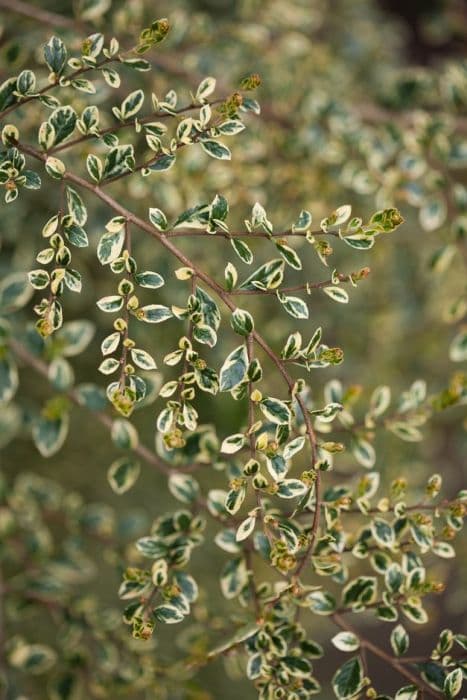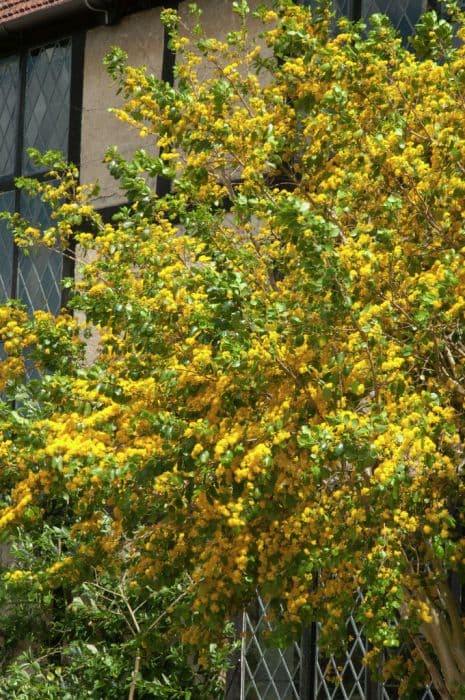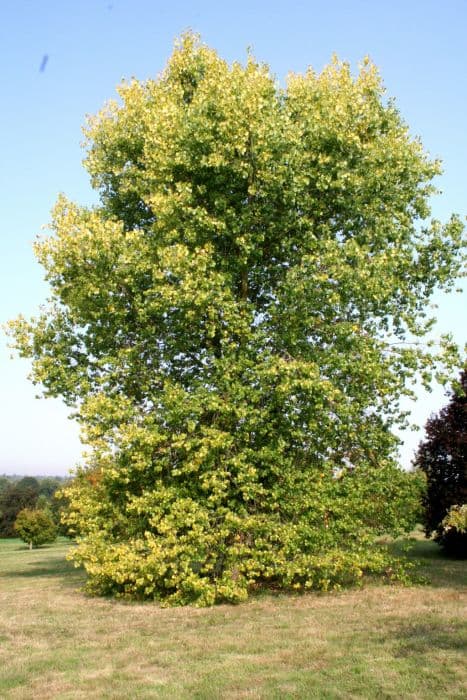Loisel Azara lanceolata

ABOUT
Azara lanceolata, commonly known as the orange-spice bush, is a visually striking plant with a neat and dense growth habit that conveys an ornamental quality. The leaves are small, glossy, and lance-shaped, producing a sleek, textured look as they cluster densely on the branches. Their dark green hue provides a lush backdrop, which makes the tiny, yet fragrant flowers stand out when they bloom. These flowers are typically a bright shade of yellow, and their pleasant scent can be reminiscent of vanilla or orange, adding an aromatic dimension to the plant's allure. The orange-spice bush produces small, inedible berries that are not particularly showy but do contribute to its overall aesthetic. The berries are typically a dark color when ripe, often black or purple, and they provide a subtle contrast to the foliage. Overall, the plant's appearance is characterized by its neat, bushy form, evergreen leaves, and delightfully scented blooms that can be a sensory delight in a garden setting.
About this plant
 Names
NamesFamily
Salicaceae
Synonyms
Orange Spice Azara, Lofty Azara
Common names
Azara integrifolia, Azara alpina.
 Toxicity
ToxicityTo humans
Azara lanceolata, commonly known as Azara, is not widely documented as a toxic plant to humans. There is limited information on its toxicity, and it is not typically listed among plants that are known to be poisonous when ingested. However, due to the general lack of data, it is advisable to err on the side of caution and avoid ingesting any part of the plant. If any part of the plant is ingested and symptoms or adverse reactions occur, medical attention should be sought.
To pets
Similar to its effects on humans, Azara lanceolata, or Azara, does not have a well-documented toxicity profile for pets. It is not commonly recognized as a toxic plant to dogs, cats, and other domestic animals. However, since comprehensive toxicological information for pets is lacking, it is prudent to prevent pets from ingesting the plant. If a pet does consume Azara and shows signs of illness, a veterinarian should be consulted immediately.
 Characteristics
CharacteristicsLife cycle
Perennials
Foliage type
Evergreen
Color of leaves
Green
Flower color
Yellow
Height
10-20 feet (3-6 meters)
Spread
6-10 feet (2-3 meters)
Plant type
Shrub
Hardiness zones
7
Native area
South America
Benefits
 General Benefits
General Benefits- Ornamental value: Azara lanceolata, commonly known as Loasa, is often cultivated for its attractive foliage and habit.
- Wildlife support: Provides food and shelter for various species of birds and insects.
- Habitat enhancement: Can be used in landscaping to create naturalized areas that enhance biodiversity.
- Windbreak: Its dense growth habit makes it suitable as a windbreak in coastal areas or gardens.
- Privacy screen: Due to its fullness and height, it can be used to create privacy screens in gardens or along property lines.
- Hardiness: Loasa is known for its ability to withstand less than ideal soil conditions and some degree of neglect.
- Erosion control: Its root system can help stabilize soil and prevent erosion on slopes.
- Seasonal interest: Provides year-round visual interest due to its evergreen nature, with added attraction when flowering.
 Medical Properties
Medical PropertiesThis plant is not used for medical purposes.
 Air-purifying Qualities
Air-purifying QualitiesThis plant is not specifically known for air purifying qualities.
 Other Uses
Other Uses- Insect Attractant: Azara lanceolata can be used in gardens to attract beneficial insects, which can help with pollination and natural pest control.
- Woodworking: The wood from the plant is hard and can be used for making small handcrafted items such as tool handles, inlays, and turned objects.
- Windbreak: With its dense foliage, it can serve as an effective windbreak in coastal and windy areas, protecting homes and gardens.
- Hedge Plant: Azara lanceolata can be trimmed and maintained as a hedge, offering privacy or acting as a garden border.
- Erosion Control: The plant’s root system can help stabilize soil and control erosion, particularly on slopes.
- Perfumery: The tiny flowers of Azara lanceolata emit a pleasant fragrance that has been used in the crafting of natural perfumes and scents.
- Fodder: Although not common, the leaves can potentially be used as fodder for certain types of livestock tolerant to its specific compounds.
- Architectural Ornamentation: The plant can be used in landscape architecture for its evergreen appearance and ornamental values.
- Fruit Dye: The dark color of the fruit might be used for natural dye experiments in artisanal textile processes.
- Floral Arrangements: The aromatic flowers and shiny leaves can be included in floral arrangements for both aesthetic and olfactory elements.
Interesting Facts
 Feng Shui
Feng ShuiAzara is not used in Feng Shui practice.
 Zodiac Sign Compitability
Zodiac Sign CompitabilityAzara is not used in astrology practice.
 Plant Symbolism
Plant Symbolism- Obscurity: Azara lanceolata, commonly known as "Loquat,” is not widely known for its symbolic meanings, which could be a symbol for things that are hidden or not in plain sight.
- Rarity: Given its relative obscurity in the realm of symbolism, Loquat can represent rarity or unique characteristics that are not commonly found.
- Beauty: The plant itself, with its attractive foliage and fragrant flowers, can symbolize natural beauty and the appreciation of aesthetics that may not be immediately obvious.
- Resilience: As a plant that can adapt to various conditions, Loquat may symbolize resilience and the ability to thrive in adversity.
 Water
WaterFor the Azara microphylla, commonly referred to as the small-leaved azara, water the plant deeply and thoroughly, allowing the soil to become moderately dry between waterings. On average, this might mean watering with about 1-2 gallons every week during the growing season, but always adjust according to the weather and soil conditions. In the winter, reduce watering, and only provide enough to prevent the soil from completely drying out, which might equate to watering every couple of weeks with minimal amounts.
 Light
LightThe small-leaved azara thrives in full sun to partial shade. The best spot for this plant would be where it can receive at least 4 to 6 hours of direct sunlight daily, though it can also tolerate and do well in dappled sunlight throughout the day. Avoid placing it in deep shade, as this can lead to poor growth and fewer flowers.
 Temperature
TemperatureSmall-leaved azara plants prefer a temperate climate with temperatures ranging from 50°F to 70°F. They can tolerate a minimum temperature down to about 20°F, but frost can damage the foliage. Ideally, they should be protected from extreme cold and hot temperatures to maintain their health and appearance.
 Pruning
PruningPrune the small-leaved azara to maintain its shape and remove any dead or damaged branches, encouraging healthy growth and air circulation. The best time for pruning is late winter or early spring, just before the new growth starts. Pruning can be performed annually or as needed when you notice parts of the plant require attention to maintain its aesthetic appeal.
 Cleaning
CleaningAs needed
 Soil
SoilLoquat Azara thrives in well-draining, fertile soil with a pH of 5.0 to 7.5. A mix of two parts loam, one part peat moss, and one part sand or perlite is ideal for ensuring proper drainage and fertility.
 Repotting
RepottingLoquat Azara should be repotted every 2-3 years or when it becomes root-bound. Early spring, just before new growth starts, is the best time to repot this plant.
 Humidity & Misting
Humidity & MistingLoquat Azara prefers moderate to high humidity levels, ideally between 40-60%. Maintaining a stable environment away from dry air currents will help the plant thrive.
 Suitable locations
Suitable locationsIndoor
Place Loquat Azara in bright, indirect light and ensure moderate humidity.
Outdoor
Plant Loquat Azara in a sheltered spot with dappled sunlight and protect from frost.
Hardiness zone
8-10 USDA
 Life cycle
Life cycleAzara lanceolata, commonly known as the Lanceleaf Azara, begins its life cycle as a seed typically dispersed by birds that have eaten its fruits. Upon germination, when conditions are favorable with ample moisture and light, the seed develops into a seedling with a basic root system and leaves. The seedling then grows into a juvenile plant, where it slowly matures and the root system becomes more established. As it enters adulthood, the Lanceleaf Azara develops into a small to medium-sized evergreen shrub, producing leaves that are lance-shaped with finely serrated margins. During this stage, the plant starts flowering, typically in late winter to early spring, followed by the production of small, fragrant yellow flowers that attract pollinators. After pollination, the flowers develop into small berry-like fruits, completing the cycle as these fruits are then consumed and dispersed, beginning the process anew.
 Propogation
PropogationPropogation time
Spring to Summer
For Azara lanceolata, commonly known as maqui or the narrow-leaved Azara, the most popular method of propagation is by semi-hardwood cuttings. This is typically done during the late summer when the new growth has begun to mature and harden slightly. To propagate, a grower would take a cutting of about 4 to 6 inches (10 to 15 centimeters) from a healthy stem, ensuring there are at least two sets of leaves. The bottom set of leaves is removed, and the cut end is dipped in rooting hormone powder to enhance root development. The prepared cutting is then inserted into a pot filled with a well-draining rooting medium such as a mixture of peat and perlite. The pot is placed in a warm, humid environment, out of direct sunlight, to encourage rooting, which usually takes several weeks. During this time, the cutting should be kept moist but not waterlogged to prevent rot.









